A doksi online olvasásához kérlek jelentkezz be!
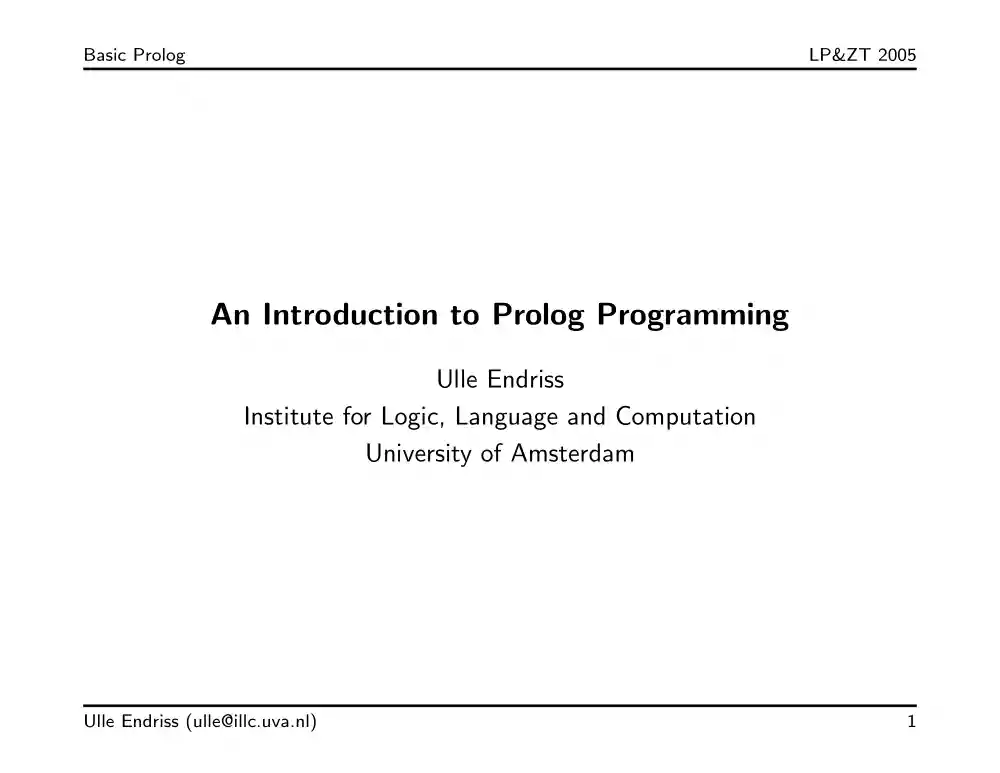
A doksi online olvasásához kérlek jelentkezz be!
Nincs még értékelés. Legyél Te az első!
Mit olvastak a többiek, ha ezzel végeztek?
Tartalmi kivonat
Basic Prolog LP&ZT 2005 An Introduction to Prolog Programming Ulle Endriss Institute for Logic, Language and Computation University of Amsterdam Ulle Endriss (ulle@illc.uvanl) 1 Basic Prolog LP&ZT 2005 What is Prolog? • Prolog (programming in logic) is a logic-based programming language: programs correspond to sets of logical formulas and the Prolog interpreter uses logical methods to resolve queries. • Prolog is a declarative language: you specify what problem you want to solve rather than how to solve it. • Prolog is very useful in some problem areas, such as artificial intelligence, natural language processing, databases, . , but pretty useless in others, such as for instance graphics or numerical algorithms. • The objective of this first lecture is to introduce you to the most basic concepts of the Prolog programming language. Ulle Endriss (ulle@illc.uvanl) 2 Basic Prolog LP&ZT 2005 Facts A little Prolog program consisting of four facts:
bigger(elephant, horse). bigger(horse, donkey). bigger(donkey, dog). bigger(donkey, monkey). Ulle Endriss (ulle@illc.uvanl) 3 Basic Prolog LP&ZT 2005 Queries After compilation we can query the Prolog system: ?- bigger(donkey, dog). Yes ?- bigger(monkey, elephant). No Ulle Endriss (ulle@illc.uvanl) 4 Basic Prolog LP&ZT 2005 A Problem The following query does not succeed! ?- bigger(elephant, monkey). No The predicate bigger/2 apparently is not quite what we want. What we’d really like is the transitive closure of bigger/2. In other words: a predicate that succeeds whenever it is possible to go from the first animal to the second by iterating the previously defined facts. Ulle Endriss (ulle@illc.uvanl) 5 Basic Prolog LP&ZT 2005 Rules The following two rules define is bigger/2 as the transitive closure of bigger/2 (via recursion): is bigger(X, Y) :- bigger(X, Y). is bigger(X, Y) :- bigger(X, Z), is bigger(Z, Y). Ulle Endriss (ulle@illc.uvanl) ↑ ↑
“if” “and” 6 Basic Prolog LP&ZT 2005 Now it works ?- is bigger(elephant, monkey). Yes Even better, we can use the variable X: ?- is bigger(X, donkey). X = horse ; X = elephant ; No Press ; (semicolon) to find alternative solutions. No at the end indicates that there are no further solutions. Ulle Endriss (ulle@illc.uvanl) 7 Basic Prolog LP&ZT 2005 Another Example Are there any animals which are both smaller than a donkey and bigger than a monkey? ?- is bigger(donkey, X), is bigger(X, monkey). No Ulle Endriss (ulle@illc.uvanl) 8 Basic Prolog LP&ZT 2005 Terms Prolog terms are either numbers, atoms, variables, or compound terms. Atoms start with a lowercase letter or are enclosed in single quotes: elephant, xYZ, a 123, ’Another pint please’ Variables start with a capital letter or the underscore: X, Elephant, G177, MyVariable, Ulle Endriss (ulle@illc.uvanl) 9 Basic Prolog LP&ZT 2005 Terms (cont.) Compound terms have a functor (an
atom) and a number of arguments (terms): is bigger(horse, X) f(g(Alpha, ), 7) ’My Functor’(dog) Atoms and numbers are called atomic terms. Atoms and compound terms are called predicates. Terms without variables are called ground terms. Ulle Endriss (ulle@illc.uvanl) 10 Basic Prolog LP&ZT 2005 Facts and Rules Facts are predicates followed by a dot. Facts are used to define something as being unconditionally true. bigger(elephant, horse). parent(john, mary). Rules consist of a head and a body separated by :-. The head of a rule is true if all predicates in the body can be proved to be true. grandfather(X, Y) :father(X, Z), parent(Z, Y). Ulle Endriss (ulle@illc.uvanl) 11 Basic Prolog LP&ZT 2005 Programs and Queries Programs: Facts and rules are called clauses. A Prolog program is a list of clauses. Queries are predicates (or sequences of predicates) followed by a dot. They are typed in at the Prolog prompt and cause the system to reply. ?- is bigger(horse, X), is
bigger(X, dog). X = donkey Yes Ulle Endriss (ulle@illc.uvanl) 12 Basic Prolog LP&ZT 2005 Built-in Predicates • Compiling a program file: ?- consult(’big-animals.pl’) Yes • Writing terms on the screen: ?- write(’Hello World!’), nl. Hello World! Yes Ulle Endriss (ulle@illc.uvanl) 13 Basic Prolog LP&ZT 2005 Matching Two terms match if they are either identical or if they can be made identical by substituting their variables with suitable ground terms. We can explicitly ask Prolog whether two given terms match by using the equality-predicate = (written as an infix operator). ?- born(mary, yorkshire) = born(mary, X). X = yorkshire Yes The variable instantiations are reported in Prolog’s answer. Ulle Endriss (ulle@illc.uvanl) 14 Basic Prolog LP&ZT 2005 Matching (cont.) ?- f(a, g(X, Y)) = f(X, Z), Z = g(W, h(X)). X = a Y = h(a) Z = g(a, h(a)) W = a Yes ?- p(X, 2, 2) = p(1, Y, X). No Ulle Endriss (ulle@illc.uvanl) 15 Basic Prolog LP&ZT 2005
The Anonymous Variable The variable (underscore) is called the anonymous variable. Every occurrence of represents a different variable (which is why instantiations are not being reported). ?- p( , 2, 2) = p(1, Y, ). Y = 2 Yes Ulle Endriss (ulle@illc.uvanl) 16 Basic Prolog LP&ZT 2005 Answering Queries Answering a query means proving that the goal represented by that query can be satisfied (according to the programs currently in memory). Recall: Programs are lists of facts and rules. A fact declares something as being true. A rule states conditions for a statement being true. Ulle Endriss (ulle@illc.uvanl) 17 Basic Prolog LP&ZT 2005 Answering Queries (cont.) • If a goal matches with a fact, then it is satisfied. • If a goal matches the head of a rule, then it is satisfied if the goal represented by the rule’s body is satisfied. • If a goal consists of several subgoals separated by commas, then it is satisfied if all its subgoals are satisfied. • When
trying to satisfy goals with built-in predicates like write/1 Prolog also performs the associated action (e.g writing on the screen). Ulle Endriss (ulle@illc.uvanl) 18 Basic Prolog LP&ZT 2005 Example: Mortal Philosophers Consider the following argument: All men are mortal. Socrates is a man. Hence, Socrates is mortal. It has two premises and a conclusion. Ulle Endriss (ulle@illc.uvanl) 19 Basic Prolog LP&ZT 2005 Translating it into Prolog The two premises can be expressed as a little Prolog program: mortal(X) :- man(X). man(socrates). The conclusion can then be formulated as a query: ?- mortal(socrates). Yes Ulle Endriss (ulle@illc.uvanl) 20 Basic Prolog LP&ZT 2005 Goal Execution (1) The query mortal(socrates) is made the initial goal. (2) Prolog looks for the first matching fact or head of rule and finds mortal(X). Variable instantiation: X = socrates (3) This variable instantiation is extended to the rule’s body, i.e man(X) becomes man(socrates). (4)
New goal: man(socrates). (5) Success, because man(socrates) is a fact itself. (6) Therefore, also the initial goal succeeds. Ulle Endriss (ulle@illc.uvanl) 21 Basic Prolog LP&ZT 2005 Programming Style It is extremely important that you write programs that are easily understood by others! Some guidelines: • Use comments to explain what you are doing: /* This is a long comment, stretching over several lines, which explains in detail how I have implemented the aunt/2 predicate . */ aunt(X, Z) :sister(X, Y), parent(Y, Z). Ulle Endriss (ulle@illc.uvanl) % This is a short comment. 22 Basic Prolog LP&ZT 2005 Programming Style (cont.) • Separate clauses by one or more blank lines. • Write only one predicate per line and use indentation: blond(X) :father(Father, X), blond(Father), mother(Mother, X), blond(Mother). (Very short clauses may also be written in a single line.) • Insert a space after every comma inside a compound term: born(mary, yorkshire,
’01/01/1980’) • Write short clauses with bodies consisting of only a few goals. If necessary, split into shorter sub-clauses. • Choose meaningful names for your variables and atoms. Ulle Endriss (ulle@illc.uvanl) 23 Basic Prolog LP&ZT 2005 Summary: Syntax • All Prolog expression are made up from terms (numbers, atoms, variables, or compound terms). • Atoms start with lowercase letters or are enclosed in single quotes; variables start with capital letters or the underscore. • Prolog programs are lists of facts and rules (clauses). • Queries are submitted to the system to initiate a computation. • Some built-in predicates have special meaning. Ulle Endriss (ulle@illc.uvanl) 24 Basic Prolog LP&ZT 2005 Summary: Answering Queries • When answering a query, Prolog tries to prove that the corresponding goal is satisfiable (can be made true). This is done using the rules and facts given in a program. • A goal is executed by matching it with the first
possible fact or head of a rule. In the latter case the rule’s body becomes the new goal. • The variable instantiations made during matching are carried along throughout the computation and reported at the end. • Only the anonymous variable can be instantiated differently whenever it occurs. Ulle Endriss (ulle@illc.uvanl) 25
bigger(elephant, horse). bigger(horse, donkey). bigger(donkey, dog). bigger(donkey, monkey). Ulle Endriss (ulle@illc.uvanl) 3 Basic Prolog LP&ZT 2005 Queries After compilation we can query the Prolog system: ?- bigger(donkey, dog). Yes ?- bigger(monkey, elephant). No Ulle Endriss (ulle@illc.uvanl) 4 Basic Prolog LP&ZT 2005 A Problem The following query does not succeed! ?- bigger(elephant, monkey). No The predicate bigger/2 apparently is not quite what we want. What we’d really like is the transitive closure of bigger/2. In other words: a predicate that succeeds whenever it is possible to go from the first animal to the second by iterating the previously defined facts. Ulle Endriss (ulle@illc.uvanl) 5 Basic Prolog LP&ZT 2005 Rules The following two rules define is bigger/2 as the transitive closure of bigger/2 (via recursion): is bigger(X, Y) :- bigger(X, Y). is bigger(X, Y) :- bigger(X, Z), is bigger(Z, Y). Ulle Endriss (ulle@illc.uvanl) ↑ ↑
“if” “and” 6 Basic Prolog LP&ZT 2005 Now it works ?- is bigger(elephant, monkey). Yes Even better, we can use the variable X: ?- is bigger(X, donkey). X = horse ; X = elephant ; No Press ; (semicolon) to find alternative solutions. No at the end indicates that there are no further solutions. Ulle Endriss (ulle@illc.uvanl) 7 Basic Prolog LP&ZT 2005 Another Example Are there any animals which are both smaller than a donkey and bigger than a monkey? ?- is bigger(donkey, X), is bigger(X, monkey). No Ulle Endriss (ulle@illc.uvanl) 8 Basic Prolog LP&ZT 2005 Terms Prolog terms are either numbers, atoms, variables, or compound terms. Atoms start with a lowercase letter or are enclosed in single quotes: elephant, xYZ, a 123, ’Another pint please’ Variables start with a capital letter or the underscore: X, Elephant, G177, MyVariable, Ulle Endriss (ulle@illc.uvanl) 9 Basic Prolog LP&ZT 2005 Terms (cont.) Compound terms have a functor (an
atom) and a number of arguments (terms): is bigger(horse, X) f(g(Alpha, ), 7) ’My Functor’(dog) Atoms and numbers are called atomic terms. Atoms and compound terms are called predicates. Terms without variables are called ground terms. Ulle Endriss (ulle@illc.uvanl) 10 Basic Prolog LP&ZT 2005 Facts and Rules Facts are predicates followed by a dot. Facts are used to define something as being unconditionally true. bigger(elephant, horse). parent(john, mary). Rules consist of a head and a body separated by :-. The head of a rule is true if all predicates in the body can be proved to be true. grandfather(X, Y) :father(X, Z), parent(Z, Y). Ulle Endriss (ulle@illc.uvanl) 11 Basic Prolog LP&ZT 2005 Programs and Queries Programs: Facts and rules are called clauses. A Prolog program is a list of clauses. Queries are predicates (or sequences of predicates) followed by a dot. They are typed in at the Prolog prompt and cause the system to reply. ?- is bigger(horse, X), is
bigger(X, dog). X = donkey Yes Ulle Endriss (ulle@illc.uvanl) 12 Basic Prolog LP&ZT 2005 Built-in Predicates • Compiling a program file: ?- consult(’big-animals.pl’) Yes • Writing terms on the screen: ?- write(’Hello World!’), nl. Hello World! Yes Ulle Endriss (ulle@illc.uvanl) 13 Basic Prolog LP&ZT 2005 Matching Two terms match if they are either identical or if they can be made identical by substituting their variables with suitable ground terms. We can explicitly ask Prolog whether two given terms match by using the equality-predicate = (written as an infix operator). ?- born(mary, yorkshire) = born(mary, X). X = yorkshire Yes The variable instantiations are reported in Prolog’s answer. Ulle Endriss (ulle@illc.uvanl) 14 Basic Prolog LP&ZT 2005 Matching (cont.) ?- f(a, g(X, Y)) = f(X, Z), Z = g(W, h(X)). X = a Y = h(a) Z = g(a, h(a)) W = a Yes ?- p(X, 2, 2) = p(1, Y, X). No Ulle Endriss (ulle@illc.uvanl) 15 Basic Prolog LP&ZT 2005
The Anonymous Variable The variable (underscore) is called the anonymous variable. Every occurrence of represents a different variable (which is why instantiations are not being reported). ?- p( , 2, 2) = p(1, Y, ). Y = 2 Yes Ulle Endriss (ulle@illc.uvanl) 16 Basic Prolog LP&ZT 2005 Answering Queries Answering a query means proving that the goal represented by that query can be satisfied (according to the programs currently in memory). Recall: Programs are lists of facts and rules. A fact declares something as being true. A rule states conditions for a statement being true. Ulle Endriss (ulle@illc.uvanl) 17 Basic Prolog LP&ZT 2005 Answering Queries (cont.) • If a goal matches with a fact, then it is satisfied. • If a goal matches the head of a rule, then it is satisfied if the goal represented by the rule’s body is satisfied. • If a goal consists of several subgoals separated by commas, then it is satisfied if all its subgoals are satisfied. • When
trying to satisfy goals with built-in predicates like write/1 Prolog also performs the associated action (e.g writing on the screen). Ulle Endriss (ulle@illc.uvanl) 18 Basic Prolog LP&ZT 2005 Example: Mortal Philosophers Consider the following argument: All men are mortal. Socrates is a man. Hence, Socrates is mortal. It has two premises and a conclusion. Ulle Endriss (ulle@illc.uvanl) 19 Basic Prolog LP&ZT 2005 Translating it into Prolog The two premises can be expressed as a little Prolog program: mortal(X) :- man(X). man(socrates). The conclusion can then be formulated as a query: ?- mortal(socrates). Yes Ulle Endriss (ulle@illc.uvanl) 20 Basic Prolog LP&ZT 2005 Goal Execution (1) The query mortal(socrates) is made the initial goal. (2) Prolog looks for the first matching fact or head of rule and finds mortal(X). Variable instantiation: X = socrates (3) This variable instantiation is extended to the rule’s body, i.e man(X) becomes man(socrates). (4)
New goal: man(socrates). (5) Success, because man(socrates) is a fact itself. (6) Therefore, also the initial goal succeeds. Ulle Endriss (ulle@illc.uvanl) 21 Basic Prolog LP&ZT 2005 Programming Style It is extremely important that you write programs that are easily understood by others! Some guidelines: • Use comments to explain what you are doing: /* This is a long comment, stretching over several lines, which explains in detail how I have implemented the aunt/2 predicate . */ aunt(X, Z) :sister(X, Y), parent(Y, Z). Ulle Endriss (ulle@illc.uvanl) % This is a short comment. 22 Basic Prolog LP&ZT 2005 Programming Style (cont.) • Separate clauses by one or more blank lines. • Write only one predicate per line and use indentation: blond(X) :father(Father, X), blond(Father), mother(Mother, X), blond(Mother). (Very short clauses may also be written in a single line.) • Insert a space after every comma inside a compound term: born(mary, yorkshire,
’01/01/1980’) • Write short clauses with bodies consisting of only a few goals. If necessary, split into shorter sub-clauses. • Choose meaningful names for your variables and atoms. Ulle Endriss (ulle@illc.uvanl) 23 Basic Prolog LP&ZT 2005 Summary: Syntax • All Prolog expression are made up from terms (numbers, atoms, variables, or compound terms). • Atoms start with lowercase letters or are enclosed in single quotes; variables start with capital letters or the underscore. • Prolog programs are lists of facts and rules (clauses). • Queries are submitted to the system to initiate a computation. • Some built-in predicates have special meaning. Ulle Endriss (ulle@illc.uvanl) 24 Basic Prolog LP&ZT 2005 Summary: Answering Queries • When answering a query, Prolog tries to prove that the corresponding goal is satisfiable (can be made true). This is done using the rules and facts given in a program. • A goal is executed by matching it with the first
possible fact or head of a rule. In the latter case the rule’s body becomes the new goal. • The variable instantiations made during matching are carried along throughout the computation and reported at the end. • Only the anonymous variable can be instantiated differently whenever it occurs. Ulle Endriss (ulle@illc.uvanl) 25
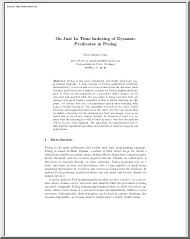
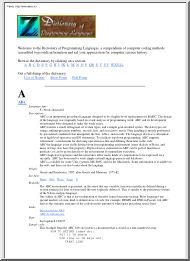
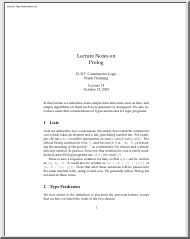
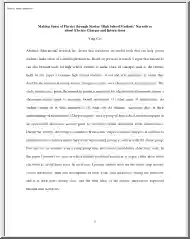
 Ahogy közeledik a történelem érettségi, sokan döbbennek rá, hogy nem készültek fel eléggé az esszéírás feladatra. Módszertani útmutatónkban kitérünk a történet térbeli és időbeli elhelyezésére, a források elemzésére és az eseményeket alakító tényezőkre is.
Ahogy közeledik a történelem érettségi, sokan döbbennek rá, hogy nem készültek fel eléggé az esszéírás feladatra. Módszertani útmutatónkban kitérünk a történet térbeli és időbeli elhelyezésére, a források elemzésére és az eseményeket alakító tényezőkre is.